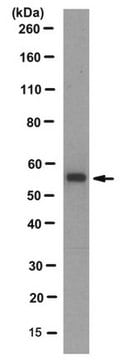About This Item
Kod UNSPSC:
12352202
NACRES:
NA.71
Polecane produkty
Postać
liquid
Poziom jakości
nie zawiera
preservative
producent / nazwa handlowa
Calbiochem®
warunki przechowywania
OK to freeze
avoid repeated freeze/thaw cycles
Warunki transportu
wet ice
temp. przechowywania
−20°C
Opis ogólny
Native TdT from calf thymus. Tdt is a DNA polymerase that catalyzes the addition of deoxynucleotides to the 3′ hydroxy terminus of either double of single stranded DNA in a template-independent manner.
Native TdT from calf thymus. Tdt is a DNA polymerase that catalyzes the addition of deoxynucleotides to the 3′ hydroxy terminus of either double of single stranded DNA in a template-independent manner. Although TdT preferentially adds deoxynucleotides to 3′-extensions, tailing onto 5′ overhangs or blunt ended double strands of DNA can also be achieved. TdT can be used for labeling DNA fragments and vectors with homopolymer tails and/or with modified deoxynucleotides such as biotin-dNTPs, 32P-dNTPs, cordycepin-dNTPs, or ddNTP.
The Calbiochem® Terminal deoxynucleotidyl Transferase (TdT) is a DNA polymerase isolated from calf thymus. TdT catalyzes the addition of deoxynucleotides to the 3′-hydroxyl termini of either double or single stranded DNA molecules in a template independent manner. Although TdT preferentially adds deoxynucleotides to 3′-extensions, tailing onto 5′ overhangs or blunt ended double strands of DNA can also be achieved. TdT can be used for labeling DNA fragments and vectors with homopolymer tails and/or with modified deoxynucleotides such as biotin-dNTPs, 32P-dNTPs, cordycepin-dNTPs, or ddNTP.
Zastosowanie
DNA Labeling
Ostrzeżenie
Toxicity: Standard Handling (A)
Definicja jednostki
One unit is the amount of enzyme required to transfer 1 nmol of dAMP from dATP to the 3ʹ-OH terminus of d(A)50 in 60 min at 37°C.
Postać fizyczna
775 Units in 50 mM potassium phosphate buffer, 1 mM B-mercaptoethanol, 50% glycerol, pH 7.2.
Rekonstytucja
Following initial thaw, aliquot and freeze (-20°C).
Inne uwagi
Chang, L.M.S. and F.J. Bollum. 1986. Crit. Rev. Biochem.21, 27.
Deng, G. and R. Wu. 1983. Methods Enzymol. 100, 96.
Michelson, A.M. and S.H. Orkin. 1982. J. Biol. Chem.257, 14773.
Roychoudhury, R. and R. Wu. 1980. Methods Enzymol.65, 43.
Nelson, T. and D. Brutlag. 1979. Methods Enzymol. 68, 41.
Roychoudhury, R., et al. 1976. Nucleic Acids Res.3, 101.
Bollum, F.J. 1974. In The Enzymes, 3rd edition (ed. P.D. Boyer), Vol. 10, 145. Academic Press, New York.
Deng, G. and R. Wu. 1983. Methods Enzymol. 100, 96.
Michelson, A.M. and S.H. Orkin. 1982. J. Biol. Chem.257, 14773.
Roychoudhury, R. and R. Wu. 1980. Methods Enzymol.65, 43.
Nelson, T. and D. Brutlag. 1979. Methods Enzymol. 68, 41.
Roychoudhury, R., et al. 1976. Nucleic Acids Res.3, 101.
Bollum, F.J. 1974. In The Enzymes, 3rd edition (ed. P.D. Boyer), Vol. 10, 145. Academic Press, New York.
Informacje prawne
CALBIOCHEM is a registered trademark of Merck KGaA, Darmstadt, Germany
This page may contain text that has been machine translated.
Kod klasy składowania
10 - Combustible liquids
Klasa zagrożenia wodnego (WGK)
WGK 2
Certyfikaty analizy (CoA)
Poszukaj Certyfikaty analizy (CoA), wpisując numer partii/serii produktów. Numery serii i partii można znaleźć na etykiecie produktu po słowach „seria” lub „partia”.
Masz już ten produkt?
Dokumenty związane z niedawno zakupionymi produktami zostały zamieszczone w Bibliotece dokumentów.
Nasz zespół naukowców ma doświadczenie we wszystkich obszarach badań, w tym w naukach przyrodniczych, materiałoznawstwie, syntezie chemicznej, chromatografii, analityce i wielu innych dziedzinach.
Skontaktuj się z zespołem ds. pomocy technicznej







